|
|||||||||
|
HERITAGE AND ARCHAEOLOGICAL NEWS BRIEFSWEST MOSQUE MUSEUM, CANGZHOU, HEBEI PROVINCE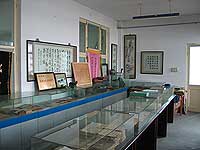 Today Cangzhou is home to two hundred thousand Muslims, a similar number to that of Muslim residents in Beijing. Cangzhou, however, has a total population of only one million people. It has seven mosques, one of which, the West Mosque, is home to one of the country's best collections of Islamic manuscripts and artefacts. This is thanks largely to the efforts of its caretaker Bai Wenhua. Cangzhou lies an hour by train to the south of Tianjin. Since the Ming Dynasty it has been one of the leading Islamic centres of north China, with traditions of Muslim martial arts, halal cuisine and Islamic learning. For centuries the leading akhunds of Beijing and Tianjin have for been trained in Cangzhou, and this continues to be the case today. 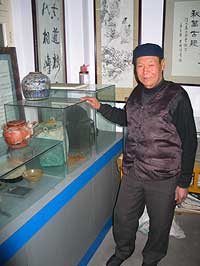 Fig. 2 Bai Wenhua. A map of towns in China that have large Hui (Sinophone Muslim) populations serves as a reasonably accurate guide to the main trade routes of China during the Ming dynasty. One of these trade routes was along the Grand Canal, which ran from the grain and silk producing centre of Hangzhou to Beijing, passing through a string of towns that have each have a rich Islamic heritage, notably Yangzhou, Jining, Dezhou, Cangzhou and Tianjin. Many of the historic sites along this trade route, however, are now threatened by the South-North water diversion project. Efforts by cultural conservation workers to document and preserve Islamic heritage in China are faced with particular problems. Perhaps foremost amongst these is language. Islamic manuscripts are one of the key elements of Islamic heritage, and these are found in several different written languages including Arabic, Persian, Chinese written in Arabic script (xiaojing) and classical Chinese. Few Muslim heritage workers today are fluent in any of these written languages. While many religious professionals are able to read Arabic and sometimes Persian and Arabo-Chinese texts, their skills are rarely enlisted by the government agencies whose task it is to preserve threatened traditions. For example, at one of the leading state-funded research institutions that has a brief to enchance the understanding of China's non-Han peoples, the library's collection of Arabic, Persian and Uyghur manuscripts collected in the 1950s and 1960s from different parts of China lies uncatalogued in a locked cupboard, as the institution in question has been unable to find a librarian capable of doing the necessary work of identifying the material. Language difficulties aside, the many manuscripts held in private hands tend to be closely guarded by their owners, a situation that is understandable given the destruction of religious materials that took place in the past. This bleak situation has started to change over the last few years, as octogenarians owners of manuscripts hand over their prized possessions to a new generation of religious professionals who are aware of the importance and methodologies of cultural preservation work. Bai Wenhua, the caretaker of the West Mosque in Cangzhou mentioned earlier, is one such religious professional. Many of the several dozen manuscripts and material artefacts in the collection of the West Mosque Museum were either gathered by Bai Wenhua locally, or donated by people concerned about the longer term survival of cherished cultural artefacts. THE WEST MOSQUE COLLECTION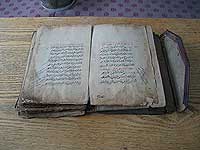 Fig. 3 Opening page of the Yang family Quran manuscript, with Arabic margin notes. 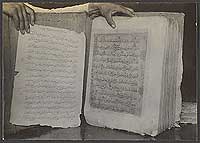 Fig. 4 The Salar Quran manuscript. This photo, taken by an American missionary in the 1930s, shows what is generally considered to be the oldest Quran manuscript in China. The prize item in the West Mosque collection is a hand-copied manuscript of the Quran in two leather-bound volumes, recently donated by Akhund Yang Guorong of Xiji, Ningxia. The Quran has Arabic margin notes throughout which are written in several hands. This is one of only a handful of Quran manuscripts of considerable vintage that were hand-copied in China, and the sole example known to this author with marginalia. According to Yang, the Quran was originally copied by his ancestor over two hundred years ago, and passed down to him through fourteen successive generations of akhunds. He claims that his family have been followers of the Jahriyya tariqat (Sufi organisation) for as long as this Quran has existed, and so the margin comments present a rich historical portrait of Quranic exegesis in one of the better-known Islamic organisations in China. 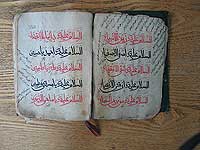 Fig. 5 The Niu Zhanhua manuscript of the mawlid poetry text commemorating the birth of the Prophet Muhammad, titled Madayih. 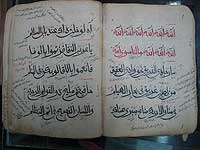 Fig. 5a A page from the Madayih. In the Jahriyya sufi order (Arabic: tariqat), this praise poem is used as a liturgical text for recitation on the anniversaries of the death of passed leaders of the order.  Fig. 6 Some of the Chinese language Islamic texts at the West Mosque. The text on the bottom right is Origins of the Huihui, one of the accounts of communal origins popular amongst Chinese Muslims in the Qing dynasty. Another noteworthy item in the museum's collection is a two hundred-year old handwritten copy of Madayih (literally, "praise"), a mawlud poetry text in praise of the birth of Muhammad. This text plays a liturgical function in the Jahriyya tariqat, and is recited at the mass ceremonies convened in honour of the departed leaders of that order. The history of this particular text provides a synopsis of the history of this group in China. In 1818, the third leader of the Jahriyya, Ma Datian, was exiled to Manchuria for taking delivery of a type of melon that was reserved as a tribute item for the exclusive use of the imperial household. A number of followers of the Jahriyya accompanied their leader into voluntary exile, including Master Niu who took with him this copy of Madayih. The text remained in Manchuria until it was purchased in 1953 by Shi Jinglan of Botou, the next town down the Grand Canal from Cangzhou. Partly thanks to being isolated from the large Jahriyya communities of Ningxia and Gansu, the text managed to survive the Cultural Revolution unscathed, and was donated by Shi Jinglan to the West Mosque in 2005. As with the Quran manuscript described above, the margin notes have a lot to say, here in Persian and Chinese written in Arabic script (xiaojing). 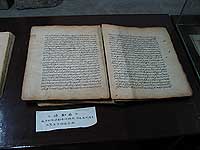 Fig 7 A page from a manuscript of the Persian book known as Farsi, one of the textbooks used in Chinese madrasas. The West Mosque also has a substantial collection of manuscripts and printed editions of texts used in Chinese madrasas, painstakingly gathered from the local Muslim community. Amongst these are a dozen texts formerly owned by the Jahriyya Akhund Jin Shiyi, who was the Jahriyya representative in the Shandong and Hebei region at the turn of the 20th century. The texts of Jin Shiyi provide an excellent sample of the Arabic, Persian and Chinese editions that were popular in the Chinese madrasa education system a century ago. 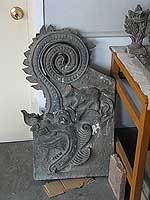 Fig. 8 Dragon and lamb carving, which probably once hung from the roof eave of a local mosque. Amongst the material items in the West Mosque collection are a dozen century-old items of everyday use, such as ceramic jugs and bronze buckets used for ritual washing, prayer beads and two examples of the six-sided hat worn during rituals by members of the Jahriyya tariqat. Also in the collection are three fragments of Arabic tomb inscriptions from the Ming Dynasty, and a number of stone fragments with animal and plant motifs collected from the grounds of mosques that were destroyed during the Cultural Revolution. In keeping with the budget and limited ambitions of the museum, no attempt has been made to translate, comment upon or categorise any of these items. [AHG] |